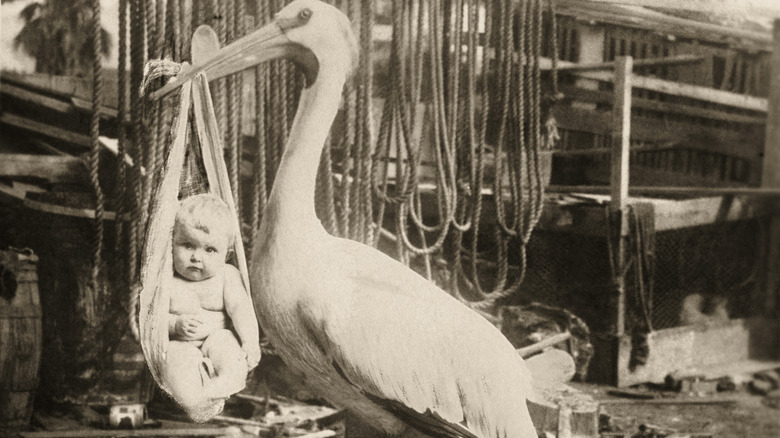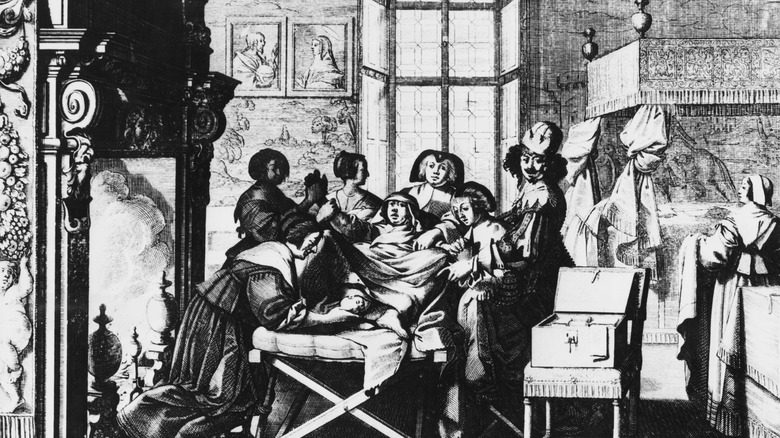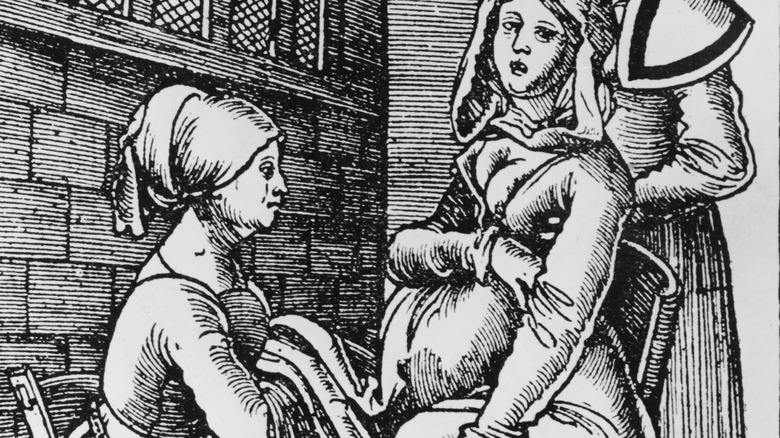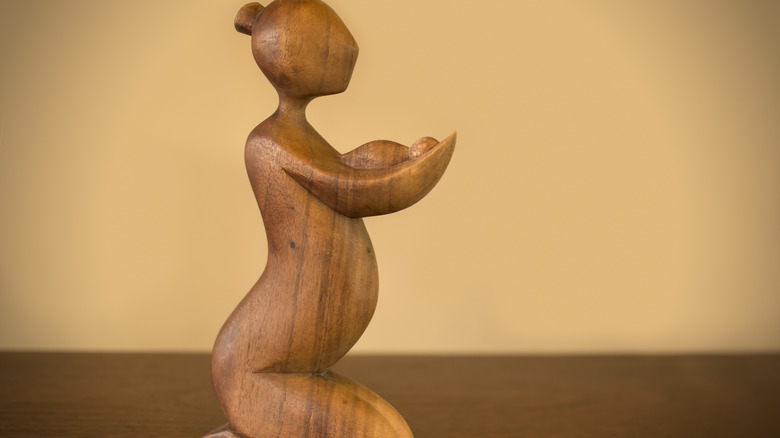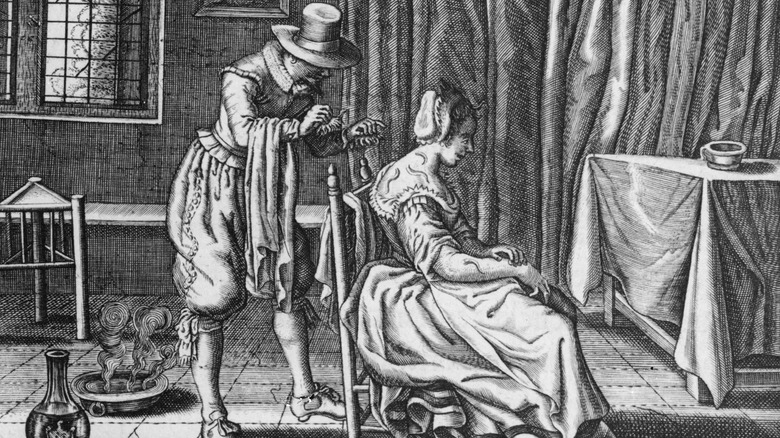Things People Used To Believe About Childbirth
Pregnancy and childbirth were not always events that were anticipated with excitement. The history of human childbirth is filled with both the known, and long-forgotten tales of women and babies who perished in its wake. Breech deliveries, childbed fever, and stillborn births are just a scant few of the risks inherent in women's role in keeping the human race in existence.
Ritual and superstition often played a significant part of a natural process that few had any control over. The histories of such rituals and beliefs are vast, with some parts of the world still practicing traditional rituals based not in science, but in culture.
Many of these historical beliefs about childbirth have been debunked by science. Others show just how intuitive midwives and birthing women have been for thousands of years.
Anglo-Saxon childbirth rituals
Anglo-Saxons in early England relied upon prayers and charms that were inspired by both pagan and Christian rituals and beliefs. Pregnant women, fearful of a difficult delivery, may have performed a number of curious rituals, and one involved both a dead man, and a live one.
Reciting the following words, "This is my remedy for hateful slow birth, this is my remedy for heavy difficult birth, this is my remedy for hateful imperfect birth," the woman would step her way over a man's grave. She would follow this by stepping over a live man, most likely her husband, saying "Up I go, step over you with a living child, not a dead one, with a full-born one, not a doomed one." Once satisfied that her pregnancy was a healthy one, she would visit the local church, where in front of the altar she would announce, "by Christ, I have said, this is manifested."
But what if it didn't work? The birth of stillborn babies was a common occurrence in early England, and there was, of course, a ritual for that too. To ensure the success of future pregnancies, the grieving mother was to take dirt from her child's grave, wrap it in wool, and sell the bundle to a merchant. She would recite the words "I sell it, you buy it, this black wool and this sorrow's seed."
Once she had given birth to a healthy child, and after her month long lying-in period, she would be "churched." Wearing a veil and accompanied by two married women, the mother would be welcomed back into the church community by the local priest. So began the medieval Catholic traditions that sought to alleviate the burden placed on women by "Eve's curse."
Women are being punished for Eve's sin
According to Genesis, women only have themselves to blame for the pain they may endure during labor. In the Bible story, Eve tempts Adam with an apple from the tree of knowledge, though it was forbidden by God. So, naturally, God punishes all women with "Eve's curse," and even throws in eternal subjugation to her husband for good measure. "Unto the woman he said, I will greatly multiply your sorrow and your conception; in sorrow you shall bring forth children; and your desire shall be to your husband, and he shall rule over you."
Medieval midwives in England carried with them a host of amulets, relics, and herbal remedies, and even recited incantations that were believed to lessen the burdens of Eve's curse, all of which were tolerated by the Roman Catholic Church. Local churches would loan out holy necklaces, belts, and even girdles, which women could wear or clutch as they implored the assistance of Saint Margaret, the patron saint of childbirth.
The Protestant Reformation, and its disdain for the use of Catholic superstitions or potions, sought an end to these creature comforts employed by women. Many, however, were still secretly practiced in birthing rooms, and eventually made their way back into the mainstream. An "eagle stone," a necklace housing a stone within a stone, represented the safety of the baby in the mother's womb, and husbands in 17th century England were encouraged to ensure that their pregnant wives were protected by one.
Pliny the Elder, and his bizarre advice
Childbirth was an incredibly risky undertaking in the ancient world, with frighteningly high death rates for mother and baby. It's no wonder that folks were eager for someone to turn to who promised to know the secrets that would aid them in their time of desperation. Enter the first century A.D.'s Pliny the Elder, who offered a host of bizarre and downright disgusting remedies said to aid the difficulties of childbirth.
Among his recommendations to woman in Greco-Roman times? He advised placing the right paw of a hyena upon a woman who was giving birth to aid delivery (but not the left paw... that would kill her!) If a spare hyena couldn't be found, Pliny said that a vulture's feather, or the skin of a snake could do in a pinch. If a baby was particularly difficult to deliver, Pliny suggested covering the mother's thighs with the fresh placenta of a dog. Pliny was quite the chef when it came to making pain-relieving potions, which may have included sow's dung mixed with honey wine, goose semen mixed with water, or the liquid from a weasel's uterus. And to help bring along the placenta? Pliny said that earthworms soaked in raisin wine should do the trick.
Gross, for sure, but scholars say it's important to note that Pliny's success in the birthing room may be due to the fact that despite the germs he brought into the mix, his remedies were keeping mothers well-hydrated, as well as focusing positive care upon their health, typically in the comfort of their own home.
A variety of elixir and drugs were used over the years
Pliny was, of course, not the only birthing expert to recommend assisting Mom with the help of a potions, elixirs, or drugs to get her through childbirth. According to a paper published in the Journal of the Royal Medical Society, the Chinese favored opium and alcohol, while the ancient Egyptians inhaled burnt turpentine.
"Caudles", used since medieval times, were midwife-crafted, time-honored recipes that often included mulled wine or even beer. Caudles were consumed not only by the birthing mom, but also by her attendants during the mother's delivery, and for the month-long "lying-in" period that followed, which forbade the mother from leaving the home. Caudles were used up until the mid-19th century, when male doctors, who had just started to pay more notice to the study of obstetrics, began to disparage their use.
Queen Victoria's insistence on the use of controversial chloroform for the birth of her eighth child in 1853, however, introduced the trend of "Chloroform a la Reine" to the delivery rooms of the upper classes. The use of chloroform became the standard in obstetrics until the end of the second world war, and was used alongside the newer discoveries of nitrous oxide and spinal epidurals, which both continue to be used in modern countries.
Childbirth in ancient Egypt
Sure women from the first century on had the wisdom of Pliny the Elder to look to, but what about women from more ancient civilizations?
In ancient Egypt, mother's bellies were rubbed with saffron and beer to induce delivery, and their backs were rubbed with the oil used to cook a fish in order to encourage their milk supply. The attention of the Gods and Goddesses were in high demand in the delivery room, with a favorite being Tawaret, a Goddess with the paws of a lion, back of a crocodile, and body of a pregnant hippopotamus.
Childbirth in ancient India and China
In ancient India and China, it was believed that surrounding a pregnant mother with beautiful things would result in a beautiful child. Pregnant women were encouraged to wear fine clothing, eat gourmet meals, create art, and listen to music. Concerts were even given on behalf of pregnant women, though they were discouraged from walking too far from the house.
Childbirth in ancient Greece
In ancient Greece, a woman's sole purpose in life was to marry and make babies. Preferably male babies, as female babies were more likely to be "exposed," meaning the father would choose to abandon the baby and leave it somewhere to die "at the mercy of the elements." It was believed that the female womb wandered throughout her body, causing otherwise unexplainable ill health, for which the only remedy was pregnancy.
The mother was seen as having a passive role in childbirth, with the fetus doing all of the work to emerge from the womb. An overdue woman may even be violently shaken to induce delivery. Knots of any kind were not permitted in the delivery room, as they brought bad luck. Mother and baby were washed thoroughly after the birth, as birth blood was also considered unlucky. The baby was then adorned with an amulet, blue beads, or even garlic to ward off the "evil eye."
Childbed fever
Childbed fever, or puerperal fever, plagued women for thousands of years. One of the most likely causes of death due to childbirth, it would manifest itself in the three days following birth. Puerperal fever claimed rich and poor alike, including Henry VIII's favorite wife, Jane Seymour. The mysterious illness would overcome the new mother with high fever, agonizing pain, fits of mania, and was almost always fatal.
It wasn't until the mid 19th century that doctors began to explore the possible causes of puerperal fever, which typically seemed to occur with mothers who had a midwife or doctor in attendance at birth. They concluded that inflammation due to pregnancy was to blame, and the answer was bloodletting. Cuts in the skin using a lancet, or even leeches, were used to remove the offending blood from the sick mother. This treatment was not reserved only for puerperal fever, but was also employed to relieve labor pain, convulsions, and distended abdomens.
We now know that puerperal fever is a bacterial infection, caused no doubt by the well-meaning midwives and doctors who traveled from patient to patient in a single day without washing their hands, or practiced in overcrowded "lying-in" hospitals. The burgeoning use of forcep-assisted births in the Victorian era likely contributed to tears and wounds in the uterus and vaginal canal of birthing mothers, leaving women even more susceptible to the infection. Hand-washing advocates like Oliver Wendell Holmes and Ignaz Philipp Semmelweis began the slow battle to alert doctors to the need for sanitary practices, which was initially viewed as an affront against doctors. Said Charles Meigs of the Jefferson Medical College in Philadelphia, in argument of Holmes' claims, "Doctors are gentlemen, and gentlemen's hands are clean."
Twilight sleep
Doctors in early-1900s Germany invented a new method of pain relief for the birthing mother called dammerschlaf, or the Freiburg Method. Initially ridiculed by American doctors, wealthy pregnant women nonetheless flocked to the German clinic, which was reported to be a luxurious retreat. Dammerschlaf, or twilight sleep, was administered as a combination of morphine and scopolamine, which promised mothers a pain free experience of which they would have no memory.
American women, in the throes of the suffragette feminist movement, clamored for the treatments to be brought to American shores, insisting twilight sleep was their right in the face of a culture that still believed that women were cursed by God to suffer during childbirth. Doctors eventually succumbed to public pressure, but were woefully undertrained in the procedure compared to their German counterparts, often cutting corners to make the procedure affordable to the masses.
Stories eventually began to leak about the true horrors of twilight sleep. It turned out that the drugs didn't curtail pain at all, just the memory of pain. Women were strapped down to beds for days at a time, screaming and thrashing in agony, often lying in their own bodily waste. Untrained nurses, infamous now for their terrible bedside manner, would care for the women, with doctors only checking in for the birth. Babies were greatly affected, and born in a drug-induced state. It is said that the imagery of a doctor slapping a newborn's bottom actually rose from the attempt to get these drugged babies to breathe.
Twilight sleep began to fall out of favor when one of its earliest champions, Francis Carmody, died while delivering her third baby using twilight sleep. The procedure was still used, however, well into the '50s and '60s, until an exposé in the Ladies Home Journal, as well as women who reported they did remember the horrors of the procedure, prompted its complete halt.
Old wives' tales
While many misguided beliefs and superstitions regarding pregnancy and childbirth can be traced back to a historical context, there are a slew of bizarre old wives' tales that have murkier origins, yet still endure.
Among some time honored favorites? The belief that eating sour foods, like pickles, would produce a baby with an equally sour disposition. Glanced at a mouse lately? Then your babe will most likely be born with a hairy birthmark. Don't take a bath, lest you risk drowning your unborn child. If you are carrying high, or find yourself craving orange juice, you are definitely carrying a girl. Cold feet or persistent headaches mean a boy. Suffering heartburn... your baby will be born with a full head of hair!
And these are just a few of the tales still told to pregnant women — there's a lot more. The one thing they have in common? None are based on scientific fact. But it's not like they do any harm. So go ahead, tie a string around a ring and dangle it over your pregnant tummy. Just don't do it while eating strawberries, or else your kid will have a splotchy face.
Wisdom in history
Looking back at this brief history of beliefs about childbirth, one could surmise that there has never been a better time to have a baby. In developed countries, the worries of childbed infections are almost completely eliminated. Religious curses and superstitions have made way for proven medical science. Pain reducing medicines have been made safer, and women have more choices than ever when it comes to how they wish to deliver their babies.
Women who favor a natural childbirth, in fact, are often drawing upon some ancient childbirth beliefs, particularly when it comes to birthing positions. The fully reclining position of a birthing mom so often seen in media and imagery is, in fact, a mostly modern invention. Known as a lithotomy, the mother lays back in a bed, with her legs placed in stirrups, to allow the doctor full access for medical intervention — but it doesn't exactly help mom in getting the strenuous job done. Science now shows that ancient birthing positions like squatting, kneeling, standing, and even the use of specially made birthing stools and chairs all allow the natural force of gravity to assist mom in delivery, while also widening her pelvis.
So science has confirmed one reality of childbirth that ancient women knew all along. As for hyena's paws and goose semen elixir? We are still waiting on the data.
